The electrical system in a DIY Camper Van is a bit pointless if you don’t have anything to power, so let’s learn how to hard-wire plugs, fans, and other accessories into your camper.
Quick note before we get started. This is just one part of an overarching “How to Install a DIY Camper Van Electrical System” series. If you’ve just stumbled on this article directly without seeing that, there are likely some things we’ve already covered. If you want to check out that step by step guide, you can do that here: https://www.explorist.life/diy-campervan-solar
Also, we have interactive solar wiring diagrams that are a complete, A to Z solution for teaching you exactly what parts go where, what size wires to use, fuse size recommendations, wire lug sizes, and all kind of other stuff to help save you time and frustration. You can check that out here: https://www.explorist.life/solarwiringdiagrams/
12v Distribution Block
We already know that all positive wires need to be protected with a fuse. A 12v Distribution Block makes a nice, organized spot to make all of your accessory runs originate from:
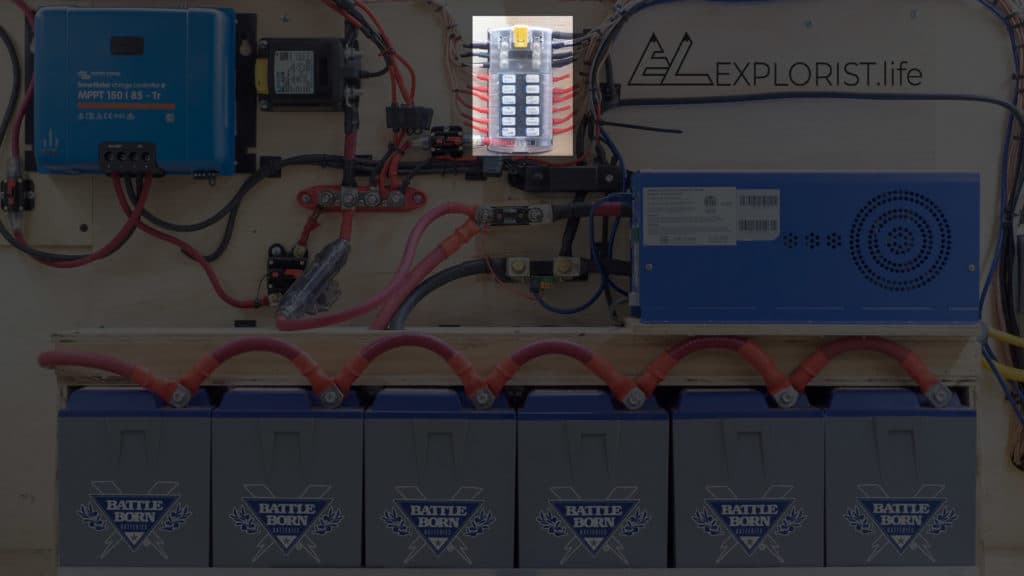
The 12v Distribution Block connects into your busbar and the one I like has enough spaces for 12 circuits and can power a max of 100 amps at a time combined between all the branch, or accessory circuits.
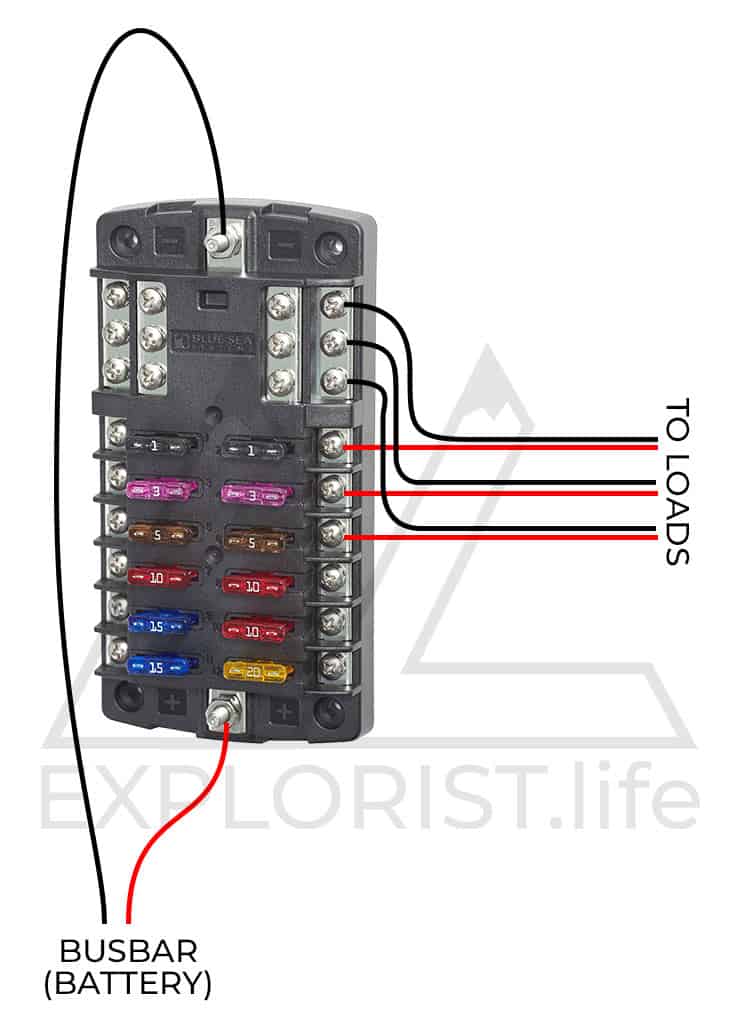
12v Wire Color
Power, Positive, and Hot (these all mean the same thing and can be used interchangeably) wires in 12v setups are typically red. Since you are likely starting this from scratch, I recommend keeping it consistent and going with red for the positive wires.
Negative and neutral (again, same thing) in 12v systems are commonly EITHER black or sometimes yellow. Keep it easy and consistant here and go with black for your negative wires unless you have a really good specific reason to choose otherwise.
Wiring 12v Plugs in a DIY Camper
12v Plugs will power any of your plug in devices such as camera battery chargers, phones, drones, and in some cases: Refrigerators.
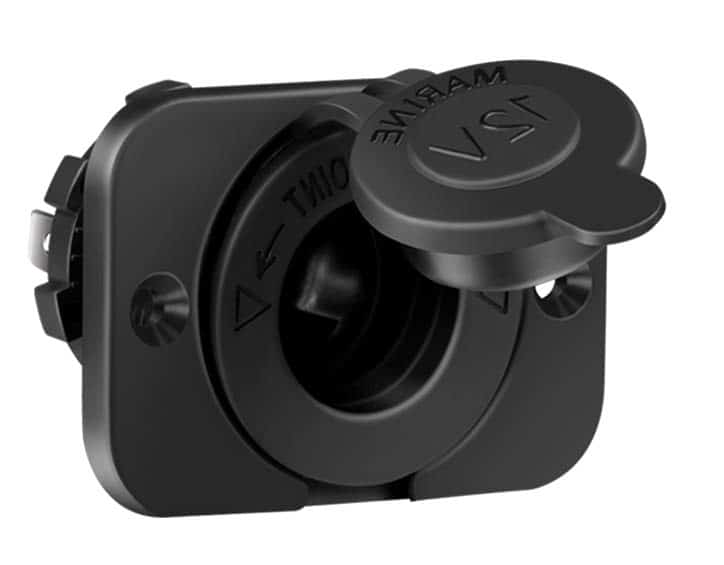
On the back of the Standard 12v Plug, there will be 2 pins that you’ll attach your wires to with spade connectors.
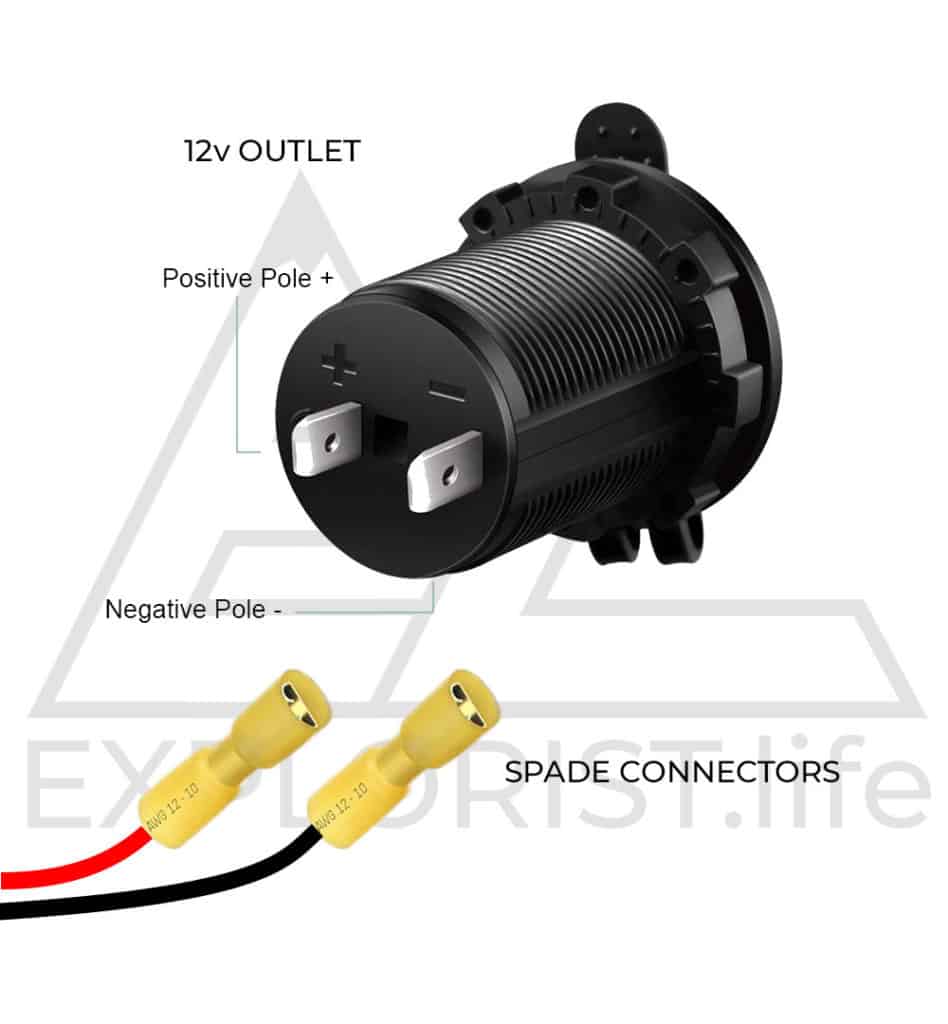
Chaining Multiple 12v Outlets
If you want to chain multiple 12v outlets on the same
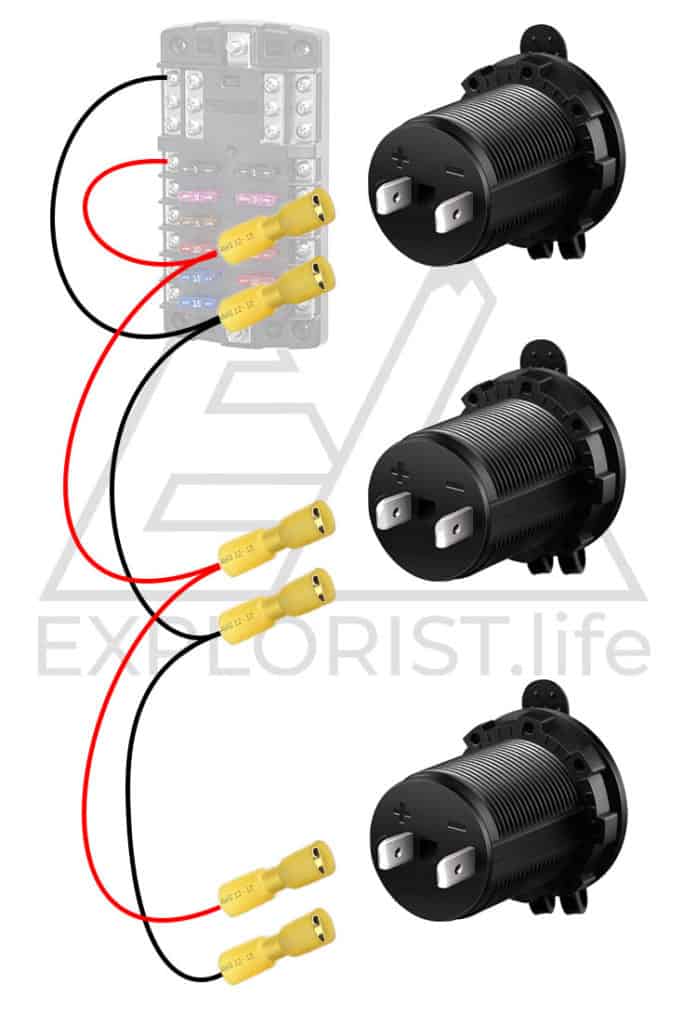
If you decide to wire multiple 12v outlets in the same circuit, please stay aware of how many total amps you anticipate using in their ENTIRE cicuit and size your fuse and wire size appropriately.
I actually don’t like wiring multiple 12v outlets in series, personally. I prefer running 1 x 12v outlet per fused circuit from the distribution block.
Wiring 12v DIY Camper Van Accessories:
Most 12v Accessories can be wired using the exact same methods as described above. Fans, refrigerators, 4g booster, etc..
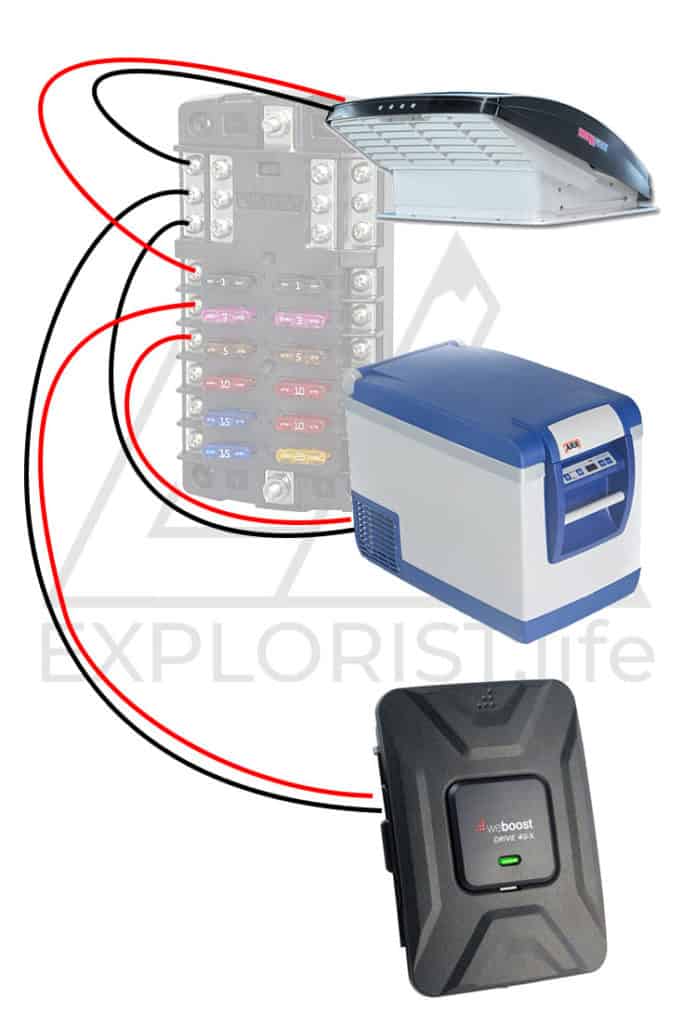
12v accessory wire
I’m a big fan of 12ga duplex wire for 12v circuits. It’s big enough for 95% of accessory circuits and when installed in lengths consistent with being installed inside a camper stays within the 3% voltage drop range even though, most of the time it isn’t necessary. It’s a red and black wire with high-grade, 105°C insulation contained inside of a white protective sheath
Now that you’ve learned how to wire 12v accessories and a distribution block, it’s time to learn how to wire lights and things that require switches. In this next lesson we are even going to talk about wiring in 2-way switches so don’t miss it. Check that out here:
https://www.explorist.life/how-to-wire-12v-lights-switches-2-way-switches-in-a-camper/
Everything that you are learning here is put to use in our FREE Interactive Solar Wiring Diagrams. If you haven’t yet, check them out as they are a complete solution for a camper van electrical system. Check them out here: https://www.explorist.life/solarwiringdiagrams/
Remember, this is just one part of a full camper van electrical educational series. To see all of the individual guides, click here: https://www.explorist.life/diy-campervan-solar
Finally, If you found this guide helpful, It’d truly mean the world to us if you’d share it with somebody who can use it, pin it to pinterest for later reference, or share it to a facebook group when somebody has a question about this subject. Click the bubble in the lower right corner to subscribe to be notified of future updates and as always, leave any questions you’ve got in the comments below.
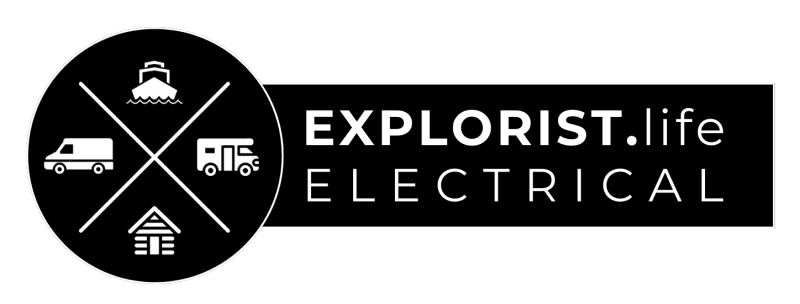
42 Responses
For some reason when they put solar on our camper and fixed the house battery to be charged by both solar and using alternator from battery, they didn’t install any 12 volt outlets, only used the inverter and installed 110/120 outlets, so I had no way to use my 12 volt appliances. I have a little fridge/freezer, an electric blanket, a fan, and a Hot Logic Mini which are all 12 volt appliances. I do not want to waste electricity by going back down from the 110/120 which would waste electricity. I think I should have a fuse for each one of them, so i outlet per circuit.
Darn! Sounds like a cool project. Good luck!
What are your thoughts on splicing into the power that feeds the water pump? I want to add a 12v hard wired reading light and it would be a pain to try to fish the wire to the panel. An inline fuse is planned also. You have helped me out a few times already and I really appreciate it. Thanks so much.
Although not necessary ‘best practice’, it’s ‘likely fine’.
Hey Nate!
Awesome stuff. I purchased both high res wiring diagrams from you and they’ve been super helpful. But 8 do have a question about the Maxxair Fan hookup. In that diagram are you basing that from the model that has a motorized open function? It seems like that function draws the most power and thus a larger guage wire is required. I have 2 manual fans on a Ford Transit Extended High Roof) and am thinking that 14 awg would be plenty?
I’d love your thoughts.
Here’s a wire size calculator if you want to stray from my recommendations on that one: https://www.explorist.life/wire-sizing-calculator/
Hi Nate. I’m currently designing my 12 volt circuits, but I have a question about this comment:
“I prefer running 1 x 12v outlet per fused circuit from the distribution block.”
I want to have a lot of outlets throughout my van. The breaker box has room for only twelve circuits. Are you suggesting you prefer hanging wiring an outlet to each circuit that supplies another load? For instance, put an outlet on your fridge circuit, one on your fan circuit, one on your water pump circuit, etc.
Or, are you suggesting having one circuit dedicated to each 12 volt outlet?
Thanks for you help. Like many other people, I would be lost without it.
That comment might be a bit outdated as I’ve had time to experiment a bit with the best way to teach this stuff. Basically, you can use multiple outlets… but you just have to be aware of which ones may draw more power (say… a 12v electric air pump for tires or a paddle board) and know that you may not be able to run multiple high powered devices on one circuit. Although not a free resource, this guidebook shows how, and how many outlets can reasonably be on the same circuit and their max wattages: https://shop.explorist.life/shop/all-products/solar-wiring-diagrams/12v-branch-circuits/
hi nate
i purchased your wiring diagram “optional solar array…520W”
where, oh where, in the spaghetti of wires does the shunt go, please?
thank you again for the great information!
all the best
john kumiski
The shunt is between the battery bank and the Negative Busbar and is labled as “SmartShunt” on the diagram.
I am using mostly the 12ga duplex wire for my 12v accessories like you recommend. Is it ok to connect the 12ga wire with smaller wires (e.g. 16ga for fan, 22ga for lights, etc)? If so, what’s the best way to do so?
To make those connections, you would use Lever Nuts. These (https://amzn.to/3sB5XWK) in particular can accept 2-5 wires of sizes from anywhere from 10 AWG to 20 AWG. These (https://amzn.to/3ipC9aJ) can connect 2-5 wires ranging in size from 24-12 AWG.
Hey Nate, I had a quick question. I’m planning on making a simple system in my van powered by a jackery 1000. I’m imagining connecting a distribution block to the jackery with the cigarette plug and this cord
https://www.amazon.com/dp/B01HGO2OIS/ref=cm_sw_em_r_mt_dp_Axo7FbVJ94DJQ?_encoding=UTF8&psc=1
Then lights (with switches) will connect to distribution block, and maybe a fan or other things down the road too. My question is, do I need a bus bar as well? Why or why not? Thanks for your time! I promise I looked all over your site before asking. Appreciate all the effort you put into making this resource!
You would just need the fuse block, not an additional busbar or anything.
@Nate Yarbrough, appreciate the response. Happy New Years and thank you again for the guides! This was the first place I learned about lever nuts and they look like they’re gonna come in real handy.
Hi, this is super helpful, thank you!
I have seen other diagrams where the negative wires coming from the devices goes to the negative bus bar, and here you lead them back to the fuse block…which is correct/recommended?
Happy to help! 🙂 At the risk of sounding like a jackass… The way I show in this blog post is the way I recommend. Perhaps I’m not fully understanding your question. Feel free to clarify.
Can you use house wire in the van? I have 1000 feet red and black of 12awg wire and was planing on wiring all of my lights and outlets with that.
Hi Nate,
All my wiring for 12V accessories (fan, fridge, sockets, lights, airhead toilet) will be 12 gauge stranded wire. My dilema is how to propertly make connections to these accessories as they vary from 22 to 14 gauge wire within them. Butt or Spade connectors are probably not the best. I was thinking of using WAGO compact connectors that you suggest in other treads. How would you tackle the issue if you were me? Thanks again for your insight.
https://amzn.to/2IoztsV
Hi, thank you for this amazing website. I’m just getting started on the wiring part of my bus build and I’ve run into a dilemma. Both the dimmer switch and the junction boxes take 3 wires (hot, ground, neutral) but my fuse block (Blue Sea Systems) only has space for 2 wires (hot and ground) what would I do with the neutral wire in this situation? Do I just ditch neutral altogether?
It sounds like you have an AC dimmer switch instead of a DC rated dimmer switch. If so… you should replace that dimmer switch with a switch that is rated for DC electricity.
Can you wire three DC switches to a series of lights? A three way or four way depending on who you talk to.
Yes, but it would require a 4-way-switch where the poles swap contactors when switched rated for 12V DC current, which I’m struggling to find. A diagram and explanation is somewhat useless when we can’t source the products to make it work. lol I’ll update the post if/when I find a source.
Hello Nate,
I have decided to use the electrical system layout you have created for solar/inverter/shore power. For now I only want to install wire to 12v ports, and lights on ceiling. Next year after the walls and ceiling are in, I will install major electrical; solar panels, charge controller, batteries, inverter, isolator, monitor. I plan to install the solar gland in the roof now before the ceiling goes in, and place conduit and wire before walls are in. Are there other things I should do now?
Thanks!
Just when you are planning your ‘phases’, try to be methodical on not building yourself into a corner.
Hi Nate,
Thanks for this guide. Which cable gauge and fuse size would you use to connect the battery to the fuse block?
Thanks!
Wire sizes for that are included in all of the diagrams at https://www.explorist.life/solarwiringdiagrams
Hey Nate!
Question about chaining usb charging sockets together. The USB charging socket I’m looking at has 2 charging ports each port says 5v 2.1a. With two charging ports that gives me 4.2 amps at 5v. Do I have to convert that to 12v to figure out how many amps my circuit is and multiply that by however many I want on my chain?
Thanks!
Can you have multiple connections that have switches wired to the same fuse? For example: a set of pot lights and a LED strip- each on their own switch, but connected to the same fuse?
Yep! Sure can!
Hey Nate! Thank you so much for the amazing guides and diagrams and all of the time you’ve put into this site (and your YouTube channel!). It’s been immensely helpful to my husband and I in planning our van’s electrical system.
I was wondering if it would suffice to use 12 gauge wire when multiple loads are on the same DC circuit. For example, we’ve got two Fantastic Fans installed in our van and are planning to run them in the same circuit. We’ve got a Sprinter 170″ Ext so the van is very long, therefor all our wires will be a bit longer. Should we just go with 10 gauge or 8 gauge to be safe? Both fans operating at full speed at the same time won’t pull more than 8 amps (from what I’ve read) but the distance of the wires is what I am worried about- in total from battery to fans will be around 16-18′. I know your guide specifies that 12 gauge is sufficient to handle most DC loads but I wasn’t sure if it accounted for multiple loads on the same circuit (and at a further distance that most van builds)?
We will likely run into the same issue with our lights- very low draw (0.25 amps) but we will have a dozen lights and the distance from batter to all the lights will be quite long (we’re not putting all 12 on the same circuit, but still…)
Better safe than sorry, right? Maybe we should just run 8 gauge to all our circuits containing multiple loads?
Thanks so much!
For a circuit that has 2 loads (such as your dual fan example), you’d simply add the amps together (8A in your case) and figure the wire size based on the furthest load. That’s the simplest way to do it. 8ga wire is pretty big, so I wouldn’t recommend making a blanket statement to use 8ga wire for all of your small DC loads. I think you’d end up regretting that decision. 8AWG at 40′ would put you within the 3% voltage drop range, but you COULD use as small as 14 AWG and stay within the 10% voltage drop threshold (which is still totally safe; but if your batteries get nearly empty; your fans may shut down)
What type of connections were used to wire both fans onto one circuit? I’ve been looking for an example and haven’t found anything
These are great for that: https://amzn.to/2IoztsV
What gage wire do you use from the fuse block to the battery and from the ground block to ground?
Gauges can be found on https://www.explorist.life/solarwiringdiagrams
A good source of information. Thank you???
Nate, love you guys and the info you provide. Awesome.
Can you possible in the near future update the diagrams to show the connectors ie butt connectors, spade connectors, etc – like you did above for the 12V outlet?
Also, please show how to wire an outlet to a switch.
It would be so helpful as most sites usually show just the wires from one or multiple items but not the connectors which is just as confusing when you have never done it before. Thanks.
I have been researching electrical system from my Sprinter build for weeks but learned more on your site in a couple hours than I have ever before. Do you recommend having all wiring in any kind of wire looms and use grommets? I’m worried with the wires rubbing on the metal and shorting out. Also how do I best know on which fuse to use on the distribution blocks for my runs?
Thanks!
Having wire inside of loom and using grommets is a good idea, especially in areas where it looks like rubbing can occur. For picking your fuses on the distribution block, if you’re using 12ga wire for the runs like recommended, 15 amp fuses are a good blanket statement, but if you want to get more detailed or verify that’s correct, I’d highly recommend this post: https://www.explorist.life/what-size-fuses-to-use-for-a-diy-camper-electrical-setup/
Is it best to use solid copper stranded wire or copper clad aluminum wire?
It’s best to use stranded copper wire like this: https://amzn.to/2KmuCv9